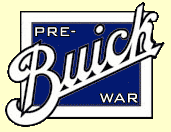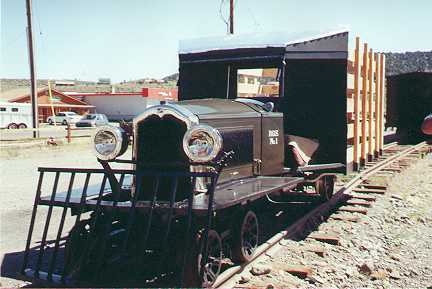 In the Colorado mountains, Karl Schaeffer has created a bit of magic. In the Colorado mountains, Karl Schaeffer has created a bit of magic.
Now, PreWarBuick is proud to bring you the story, told by Karl himself.
The Rio Grande Southern Railroad was founded by Otto Mears and built during 1891-92. It ran from Ridgway to Durango, Colorado -- 162 miles of 3-foot narrow-gauge track through the most rugged parts of the Colorado mountains. In 1930, after many hard years, the RGS went into bankruptcy. But to keep the U.S. Mail contract and handle a few passengers, the railroad decided to try using automotive based rail buses instead of costly passenger trains. They eventually built seven of these, which would become famous as the Galloping Geese.
These rail motors were immensely successful and kept the railroad operating for 20 years. This was neither the first nor the only time automobile-based rail buses were used. But owing to their success at the time, and their remarkable route, the Galloping Geese are now famous and the object of devoted followers all over the world. Geese numbers 2 through 7 all survive to this day. Numbers 1 and 2 were Buick based, Nos. 3-7 were Pierce-Arrow based.
The original RGS No. 1 was built in the Ridgway shops in 1931 from a 1925-45 or very early 1926-45 (Master Six Touring car). There were no drawings, just a lot of hayseed creativity. For a total cost of less than $850, it was finished on June 1,1931 and went into service that month between Telluride and Dolores Colorado on a 130 mile daily roundtrip schedule.
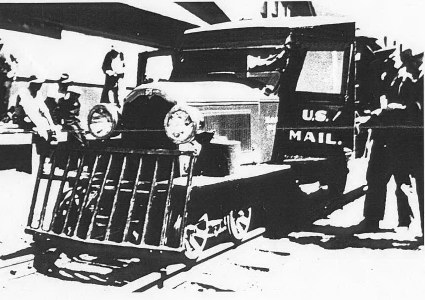 It operated very successfully until the railroad was shut down by blizzards on February 8, 1932. After a series of very heavy snow storms, No. 1 followed a steam engine with a snow plow out of Telluride, but they were only able to get to Lizard Head Pass before having to turn back. By the time the railroad reopened in May, 1932, Motors No. 2, 3 and 4 had been completed. No. 4 replaced No. 1 which, though it ran well and paid for itself in a little over two weeks, was made functionally obsolete by the later and much larger machines. It operated very successfully until the railroad was shut down by blizzards on February 8, 1932. After a series of very heavy snow storms, No. 1 followed a steam engine with a snow plow out of Telluride, but they were only able to get to Lizard Head Pass before having to turn back. By the time the railroad reopened in May, 1932, Motors No. 2, 3 and 4 had been completed. No. 4 replaced No. 1 which, though it ran well and paid for itself in a little over two weeks, was made functionally obsolete by the later and much larger machines.
No. 1 was probably used for parts to keep No. 2 running through the summer of 1932. It was written off the books in October of 1932. Only seven photos of the original are known to survive.
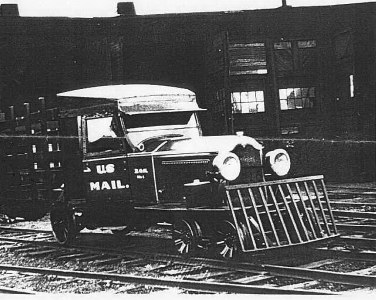 I am a retired railroader -- 23 years with the Denver & Rio Grande Western, Southern Pacific and Union Pacific. After retirement, I moved back to my favorite place in the mountains of Colorado, a few miles west of Ridgway. By chance, some folks were trying to start a local railroad museum. I got intensely involved, and decided that the best contribution I could make would be to recreate the missing first Goose. I intended to build it with most of the same tools, techniques, and materials as the original. My plan was to make it fully functional and capable of being regularly operated on the remaining narrow gauge railroads in Colorado. This meant it would have to be reliable and safe. Brakes would be a very important consideration for operating on 4% grades with a substantial load. I am a retired railroader -- 23 years with the Denver & Rio Grande Western, Southern Pacific and Union Pacific. After retirement, I moved back to my favorite place in the mountains of Colorado, a few miles west of Ridgway. By chance, some folks were trying to start a local railroad museum. I got intensely involved, and decided that the best contribution I could make would be to recreate the missing first Goose. I intended to build it with most of the same tools, techniques, and materials as the original. My plan was to make it fully functional and capable of being regularly operated on the remaining narrow gauge railroads in Colorado. This meant it would have to be reliable and safe. Brakes would be a very important consideration for operating on 4% grades with a substantial load.
After studying the history and photos, I started a search on the Internet for an appropriate Buick. I found this 1926 Model 47 in Dillon, Montana.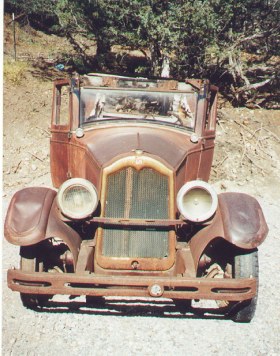 It was last operated in 1946 and was fairly complete. I paid $1500 for it and brought it back to Ridgway October 1, 1999. I made a hard push to get it stripped and the engine into the garage before first snow. During the winter, I rebuilt many components including the engine. Much of the engine was reusable, but I had to bore it and use Packard aluminum pistons. Other than this, everything under the hood is correct. After the first season of operation, I converted from the flat belt fan drive to a 1928 V-belt drive. This is something the railroad folks may well have done in 1931. It was last operated in 1946 and was fairly complete. I paid $1500 for it and brought it back to Ridgway October 1, 1999. I made a hard push to get it stripped and the engine into the garage before first snow. During the winter, I rebuilt many components including the engine. Much of the engine was reusable, but I had to bore it and use Packard aluminum pistons. Other than this, everything under the hood is correct. After the first season of operation, I converted from the flat belt fan drive to a 1928 V-belt drive. This is something the railroad folks may well have done in 1931.
During the winter, I also worked on the running gear. I was able to purchase the front wheels, with hubs. They are identical to the original, and are still in use on railroad inspection cars today. I had to make the axles, bearing blocks, and the complete front truck assembly out of standard mild steel shapes. I used the front truck(railroad term for wheels, axles, and support assembly) now under Goose No. 6 as a pattern, because I believe that's the truck originally used under No. 1.
The original Motor No. 1 used the original Buick (wooden) rear wheels with a steel railroad "tire". I doubted the currently operating railroad would allow this arrangement. The best alternative was to make solid steel replicas of the wooden wheels. I started with 1-1/2" steel plate, had it cut on a pantograph, machined, and then ground the spokes round. This took over 100 hours, but the results look pretty good. The Durango and Silverton Narrow Gauge Railroad made the tires for me out of old steam engine tender wheels.
The rear axle is the Buick part narrowed by 19 inches. I had a local machine shop do this as well as lengthen the torque tube by 17 inches. At first I used the Buick rear springs, but later found that they had to be significantly beefed up.
By early spring, I started outside on the frame. From scaling the photos, I concluded that No. 1 had an overall length of 19' 6", and a wheelbase of 137-inch wheelbase. To get this, I had to cut and extend the frame several feet, and build deck framing. Not knowing what the original frame extensions were made of, I probably overbuilt this part. The gas tank is the Buick part moved to a new location (as was done on the original No. 1) with a 6-volt electric fuel pump hidden under the deck. As it turned out, the vacuum system worked just fine and I only use the electric to prime the system.
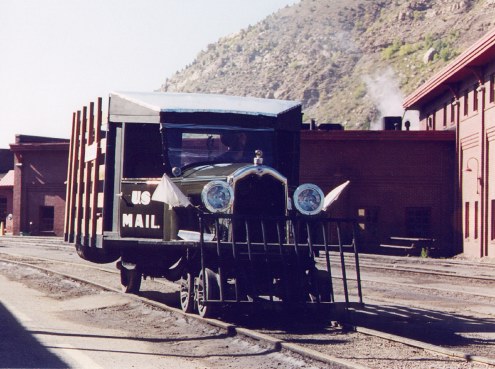 On the body, the hood, radiator (original honeycomb), doors, headlights, windshield, and cowl are original Buick parts. You may have noticed that this is now a touring car body. I found the appropriate parts in a local salvage yard, and traded the sedan parts for touring car parts. I had to make the radiator cap, fenders, cowcatcher, running boards, cab, deck, and sander pots. The dash is correct except for lack of a speedometer, no steering wheel, and the sander controls. I used the original bottom seat spring and had it upholstered with a leather look material. Since the cab is considerably wider, I also had the seat widened. John Billings of Ridgway donated much of the body work, including painting in Pullman Green, and took care of the nickel plating. Larry Billings did the glass work. Austin Baer built and donated the special door hinges. On the body, the hood, radiator (original honeycomb), doors, headlights, windshield, and cowl are original Buick parts. You may have noticed that this is now a touring car body. I found the appropriate parts in a local salvage yard, and traded the sedan parts for touring car parts. I had to make the radiator cap, fenders, cowcatcher, running boards, cab, deck, and sander pots. The dash is correct except for lack of a speedometer, no steering wheel, and the sander controls. I used the original bottom seat spring and had it upholstered with a leather look material. Since the cab is considerably wider, I also had the seat widened. John Billings of Ridgway donated much of the body work, including painting in Pullman Green, and took care of the nickel plating. Larry Billings did the glass work. Austin Baer built and donated the special door hinges.
Railroads are very sensitive to reliability and effectiveness of brakes. Toward this end, I designed a way to use the existing controls to provide a fully redundant system. The service brake applies shoes against the front wheels and activates the rear external bands. The hand brake independently operates the front brakes and the internal linings on the rear drums. Either system will stop the car as quickly as one can with steel wheels on greasy steel rails. This is one of the purposes of the sanders, which meter fine sand onto the rail behind the lead wheels. No. 1 stops more quickly than any of the other Geese.
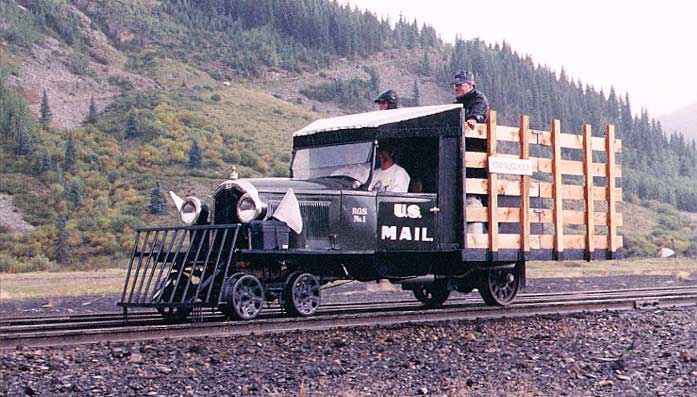 The new No. 1 moved under its own power on June 1, 2000. This was 69 years to the day after out-shopping of the original. We took it down to the Ridgway Railroad Museum on June 11, 2000 where we had enough track for me to start testing. In late July, we took No. 1 to Golden, Colorado to the Colorado Railroad Museum to test run on their half-mile loop track. We had some problems, but succeeded in accumulating 50 miles over a weekend. In late August, we took it to the Durango and Silverton Narrow Gauge railroad for Railfest 2000. This involved running 536 miles over 10 days. No. 1 performed magnificently. We did not have any breakdowns and did not have to do any significant work. The railroad was delighted to have us and we have been invited back to Railfest 2001, to be held August 23-27, 2001.
After operating in Durango, we brought No. 1 back to Ridgway where it is now on display. There is a long list of minor things yet to be done. I have built and applied door windows. As far as I know, these were a creation of the railroad rather than Buick parts. I made them removable because it gets very hot in the cab when working up long grades. The biggest thing is that I have to find or make a visor. I also have the correct 1925 headlights and will be restoring them this spring.
I have spent $12,000 and worked about 1500 hours so far on the recreation of RGS No. 1. I have donated it to the Ridgway Railroad Museum. As the Museum builds more track, it may be operated during the summer. Unless we take it to another railroad to operate for a short time, it will always be on display in Ridgway along with other freight cars and railroad artifacts.
The Ridgway Railroad Museum is a non-profit volunteer organization dedicated to preserving the history of railroading in Ouray County. Our web site is Ridgway Railroad Museum.
|
